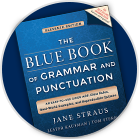Diving Back into Dialogue:
Part II
|
|
Part One of our current discussion on dialogue concerned format, punctuation, and attribution in written conversations. Part Two will center on internal dialogue that conveys what characters are thinking as opposed to speaking.
An earlier article on the subject pointed out that direct internal dialogue is expressed in the first person (I, we) and written in either quotations or italics:
"Why is he just standing there? I really wish he'd open the window."
Why is he just standing there? I really wish he'd open the window.
Indirect internal dialogue, on the other hand, conveys another character's thoughts in the third person (he, she, they); it suggests more of the author's speculation rather than a character's personal observation. It is not set off by quotation marks or italics:
Marianne wondered why Robert would not open the window.
Most inquiries about internal dialogue we receive at GrammarBook concern whether to use quotations or italics to write it.
Our current answer is that quotation marks, italics, and standard type are all acceptable formats according to the writer's style and preference, particularly when writing fiction.
Let's look further at how we might apply the different formats for direct internal dialogue.
Quotation Marks
If we envision direct internal dialogue as something audibly spoken within a character, we might treat it with quotation marks. This format also often makes the dialogue less up-close and more descriptive.
"What is wrong with me?" Robert thought. "Why is it so hard to just say what she wants—no, needs—to hear?"
But then she might start believing, "Now I've finally got him. After years of trying to reach him, to gain his silent approval, he's given me what I want and now I'm the one in control."
His thoughts shifted from "I'll say it" to "Never."
Italics
We might use italics for direct internal dialogue if we picture the thoughts as being deeper within, and thus more personal to, the character. Rather than conveying something spoken as audible to the character alone, the italics establish a mental voice with a more immediate and intimate effect.
What is wrong with me? Robert thought. Why is it so hard to just say what she wants—needs—to hear?
But then she might start believing she's got me. After years of trying to reach me and get my silent approval, she'll have what she wants and then she'll be in control.
Never.
Standard Type
Some writers may forgo both quotation marks and italics and simply stay with roman type for direct internal dialogue.
The effect is similar to italics' in conveying a greater immediacy and intimacy with a character's thoughts, particularly if the story is presented from that character's point of view.
What is wrong with me? Robert thought. Why is it so hard to just say what she wants—needs—to hear?
But then she might start believing she's got me. After years of trying to reach me and get my silent approval, she'll have what she wants and then she'll be in control.
Never.
This style can be distinctive if skillfully applied, as in author Chuck Palahniuk's novel Fight Club.
New questions and choices may still often surface when we're writing internal dialogue. As long as we remain consistent with the style we select for effect, we can make the words from within resonate with our readers.
|
View and comment on this
article on our website.
|
|
Free BONUS Quiz for You!
[[firstname]], because you are a subscriber to the newsletter, you get access to one of the Subscribers-Only Quizzes. Click here to take a Hyphens with Prefixes and Suffixes Quiz and get your scores and explanations instantly!
We will be adding many more quizzes this year to our already substantial list of quizzes. If you have suggestions for topics we have not yet covered, please send us a message at help@grammarbook.com.
|
Hundreds of Additional Quizzes
at Your Fingertips
Subscribe now to receive hundreds of additional English usage quizzes not found anywhere else!
Teachers and Employers
Save hours of valuable time! You may assign quizzes to your students and employees and have their scores tallied, organized, and reported to you! Let GrammarBook.com take the hassle out of teaching English!
"Fun to test my skills."
"The explanations really help ... thanks!"
"I can select the quizzes to assign to my students, and then the results are reported to me automatically!"
|

|
Don't need all the quizzes?
You can now purchase the same quizzes individually for ONLY 99¢ each.
Purchase yours here. |
If you think you have found an error in a quiz, please email us at help@grammarbook.com
|
 |
The Blue Book of Grammar and Punctuation
by Jane Straus, Lester Kaufman, and Tom Stern |
The Authority on English Grammar! Eleventh Edition Now Available
An indispensable tool for busy professionals, teachers, students, homeschool families, editors, writers, and proofreaders.
Available in print AND as an e-Book! Over 2,000 copies are purchased every month!
The publisher of The Blue Book, Jossey-Bass, A Wiley brand, is offering a 35 percent discount for those of you who order the book through Wiley.com. Shipping and tax are not included. Simply go to bit.ly/1996hkA and use discount code E9X4A.
Offer expires December 31, 2020.
|
Wordplay
Daffynitions
Egotist: someone who is usually me-deep in conversation.
Inflation: cutting money in half without damaging the paper.
Toothache: the pain that drives you to extraction.
Wrinkles: something other people have, similar to your character lines.
(appreciation to Phil Proctor)
|
 |
English In A Snap:
68 One-Minute English Usage Videos FREE |
Learn all about who and whom, affect and effect, subjects and verbs, adjectives and adverbs, commas, semicolons, quotation marks, and much more by just sitting back and enjoying these easy-to-follow lessons. Tell your colleagues (and boss), children, teachers, and friends. Click here to watch.
|
|




